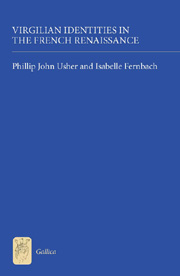Book contents
- Frontmatter
- Contents
- List of Illustrations
- Dedication
- Foreword
- List of Contributors
- Acknowledgements
- Note on Editions and Translations
- Introduction
- Part I Pastoral and Georgic Modes
- 1 Virgil and Marot: Imitation, Satire and Personal Identity
- 2 Virgil's Bucolic Legacy in Jacques Yver's Le Printemps d'Yver
- 3 On the Magical statues in lemaire de Belges's Le Temple d'honneur et de vertus
- 4 Temples of Virtue: Worshipping Virgil in Sixteenth-Century France
- 5 From Copy to Copia: Imitation and Authorship in Joachim Du Bellay's Divers Jeux Rustiques (1558)
- Part II The Epic Mode
- Index
- Already Published
2 - Virgil's Bucolic Legacy in Jacques Yver's Le Printemps d'Yver
from Part I - Pastoral and Georgic Modes
Published online by Cambridge University Press: 05 February 2013
- Frontmatter
- Contents
- List of Illustrations
- Dedication
- Foreword
- List of Contributors
- Acknowledgements
- Note on Editions and Translations
- Introduction
- Part I Pastoral and Georgic Modes
- 1 Virgil and Marot: Imitation, Satire and Personal Identity
- 2 Virgil's Bucolic Legacy in Jacques Yver's Le Printemps d'Yver
- 3 On the Magical statues in lemaire de Belges's Le Temple d'honneur et de vertus
- 4 Temples of Virtue: Worshipping Virgil in Sixteenth-Century France
- 5 From Copy to Copia: Imitation and Authorship in Joachim Du Bellay's Divers Jeux Rustiques (1558)
- Part II The Epic Mode
- Index
- Already Published
Summary
Jacques Yver's Le Printemps d'Yver is a work of prose in which three gentlemen and two noblewomen spin tales in an attempt to distract each other from the horrors of the recent third religious war (1568–70) and to rejoice in the brief 1570 Peace of Saint-Germain-en-Laye. Immediately evocative of Marguerite de Navarre's collection of seventy-two French stories, the Heptameron (1559), itself modeled after, and partly translated from, Boccaccio's Italian story collection, the Decameron (1350), Le Printemps d'Yver also appropriates and reworks, as will be discussed here, the world of virgil's Eclogues. While bearing few of the Eclogues' formal traits, the narrative tone throughout Printemps is reminiscent of that same uneasy balance between sadness and peace that we find particularly in Eclogues 1 and 9.
First published in 1572, Le Printemps d'Yver would appear in twenty more editions over the following twenty years, a period that corresponds almost exactly to the most violent period of civil war between Catholics and Protestants (1562–98). Many critics have seen in Le Printemps d'Yver a portrait of prosperous provincial society in the late sixteenth century and of this milieu's attitudes towards love, war, morals and, most significantly, the evolution of relationships between men and women. Indeed, Le Printemps d'Yver belongs, in part, to the literary tradition of the querelle des femmes, here recast against a violent political backdrop. The text's passing references to battles which occurred in Poitou and Saintonge, the areas of France that experienced the most intensive battles during the religious wars, have provided one of the few contemporary accounts of these conflicts.
- Type
- Chapter
- Information
- Virgilian Identities in the French Renaissance , pp. 39 - 58Publisher: Boydell & BrewerPrint publication year: 2012



